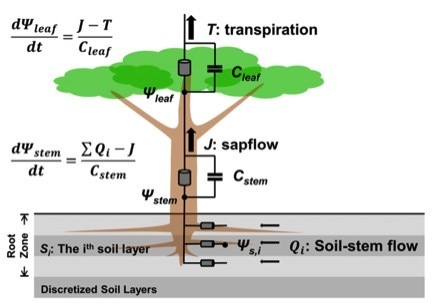Research
The Medvigy research group studies terrestrial ecosystems and their interactions with climate.

Terrestrial ecosystem and climate change: Human activity is releasing large amounts of carbon dioxide to the atmosphere. However, during the past few decades, terrestrial ecosystems have been acting as a substantial net sink of carbon dioxide: for every four molecules released by anthropogenic activity, about one molecule gets sequestered by terrestrial ecosystems. Why this proportion is one-out-of-four and whether this proportion may change in the future are questions that we do not know the answer to. In fact, increasing temperatures and changing precipitation regimes can strongly affect the properties of terrestrial ecosystems, including their ability to act as a sink of carbon dioxide. My research group strives to understand how terrestrial ecosystems respond to climate change and climate variability. The knowledge thus gained will help understand and plan for climate change.
Specific questions that we are addressing include:
1. How does lack of water affect terrestrial ecosystem productivity? We are particularly interested in this question in the context of tropical dry forests, which have been called the most threatened biome on Earth.

2. Tropical savannas are characterized by a delicate co-existence between trees and grasses. How does precipitation regime affect this co-existence?
3. Increases in atmospheric carbon dioxide may lead to a “fertilization effect” for terrestrial ecosystems; however, many terrestrial ecosystems may ultimately be limited by nutrient availability. How do different plant strategies for nutrient acquisition affect the competitive ability of plant functional groups, and what are the implications of nutrient acquisition strategies for ecosystem carbon budgets?

4. Some of the most marked temperature increases over the last few decades have occurred at high latitudes. How are boreal forests responding to changing climate?

5. Some arctic ecosystems have surprisingly been implication as sinks of atmospheric methane. Under what conditions might the Arctic act as a methane sink, now or in the future?

Deforestation of tropical rainforests and climate change: Tropical deforestation is another major driver of change in both terrestrial ecosystems and the atmosphere. About 20% of the Amazonian rainforest has already been deforested. This deforestation affects the land-atmosphere exchange of energy, water, and carbon dioxide. It is ultimately expected to affect temperature and precipitation, including in regions that have not been deforested. Have precipitation patterns already shifted in response to deforestation? Might the climate of remote regions of the work ultimately be affected by deforestation? My group seeks to these and other questions in order to improve our knowledge of the consequences of tropical deforestation for both the atmosphere and for ecosystems.

The tools we use: The Medvigy group’s approach is to use numerical models as tools for understanding. We are continually developing the Ecosystem Demography model. This model simulates the dynamics of terrestrial ecosystems on time scales from seconds to centuries, and on spatial scales from organisms to continents. We also develop other process-based vegetation models as particular research problems warrant them. We have been studying the atmosphere and land-atmosphere interactions using the Ocean-Land-Atmosphere Model. All of our models are tightly tied to empirical data through all stages of development, parameterization, and evaluation.
Collaborative research: We frequently collaborate with other groups and are generally happy to share our models. We work closely with field and laboratory scientists and are enthusiastic about using data to inform models and vice-versa. For example, we are currently are working on a DOE-funded project with Jennifer Powers (Univ. Minnesota). This project focuses on tropical dry forests. We are using measurements from Costa Rica, Mexico, Colombia, and Puerto Rico, and nutrient fertilization and rainfall exclusion experiments are being carried out in Costa Rica.

